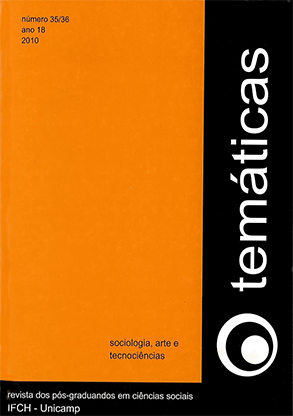Abstract
An analysis of contemporary social and urban scene shows that art and technology have been used as an expression tool of emergent sensibilities and have been responsible for the configuration of an explorative and experimental field with
critical goals. Art and technology compose, more and more intensively, daily places and objects, defining new practices related to space and, at the same time, constructing a new sociability laboratory. In this article we intend to illustrate this kind of movements, considering our actual social-cultural and urban context, and to do so we are going to refer to artistic projects that use digital technologies to explore the social and aesthetical potentials of these tools in the urban ambience.
References
POLAK, Esther; KEE, Jeroen and Waag Society. AmsterdamREALTIME 2002. www.estherpolak.nl
ARDENE, Paul. Un art contextuel. Création artistique en milieu urbain, en situation, d’intervention, de participation. Paris: Flammarion, 2004.
AURIGI, Alessandro & De Cindio, Fiorella (Ed.). Augmented Urban Spaces: Articulating the Physical and Electronic City. Burlington UK: Ashgate, 2008.
BAUDRILLARD, Jean. De la séduction. Paris: Galilée, coll. L’espace critique, 1980.
BAUDRILLARD, Jean. Les stratégies fatales. Paris : Grasset, 1983.
BENJAMIN, Walter. L’oeuvre d’art à l’époque de sa reproductibilité technique (1953), traduit de l’allemand par M. de Gandillac, Paris: Allia, 2003.
BERQUE, Augustin. Écoumène. Introduction à l’étude des milieux humains. Paris: Belin, 2001.
CASTELLS, Manuel. La société en réseaux. Paris: Fayard, 1998.
CHOAY, Françoise. Pour une Anthropologie de l’espace. Paris: Éditions du Seuil, 2006.
DEBORD, Guy. Guide psychogéographique de Paris. Discours sur les passions de l’amour. Bauhaus Imaginiste, 1957.
De KERCKHOVE, Derrick. Le virtuel, imaginaire technologique. Traverses. n°44. Paris: Éditions du Centre Georges Pompidou, septembre 1988, p. 75-85.
DURAND, Gilbert. L’imaginaire. Essai sur a science et la philosophie de l’image. Paris : Hatier, 1994.
HALBWACHS, Maurice. La mémoire collective (1950). Paris: PUF, 1969.
HARAWAY, Donna. “A Cyborg Manifesto; Science, Technology and Socialist-Feminism in the Late Twentieth Century” in Simians, Cyborgs and Women: The Reinvention of Nature New York: Routledge, 1991.
HUZINGA, Johan. Homo ludens (1938). Paris: Gallimard, 1951.
FLICHY, Patrice. L’Imaginaire d’Internet. Paris: La Découverte, 2001.
LEMOS, André. “Villes et cyberculture. Information et communication dans un nouveau “modèle d’intelligence appliqué aux cybervilles », in Sociétés, Revue de Sciences Humaines et Sociales, Bruxelles : Deboeck, N°79/ 2003/ 1.
MAFFESOLI, Michel. L’instant éternel (2000). Paris : La Table Ronde, coll. la petite vermillon, 2003.
MUMFORD, Lewis. La cité à travers l’histoire. Paris: Éditions du Seuil, 1964.
NIETZSCHE, Friedrich. La naissance de la tragédie (1872). Paris: Gallimard, coll. Folio, 1989.
RHEIGOLD, Howard. Smarts Mobs. The Next Social Revolution (2003), trad.fr. Foules intelligentes. Une revolution qui commence. Paris: M21, 2005.
SASKEN, Sassia. The global city. Princeton: Princeton University Press, 2001.
TRIBE, Mark & JANA, Reese. Art des nouveaux medias. Köln: Taschen, 2006.

This work is licensed under a Creative Commons Attribution-NonCommercial-ShareAlike 4.0 International License.
Copyright (c) 2010 Fabio La Rocca, Julieta Leite

